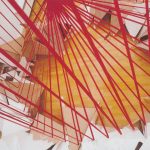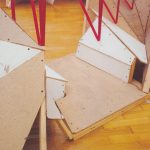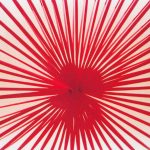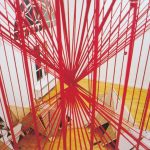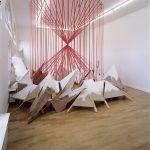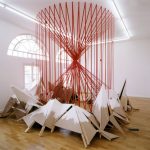Zawlazaw Kawlakaw
Tension belts, chipboard, varnish, latex paint, hockey sticks; installation at the Studiogalerie of the Kunstverein Braunschweig;
dimensions: 360 x 360 x 310 cm, 2002
World Between and Theatrum Mundi
“The dream of a narrow, glittering labyrinth tormented me to the point of excruciation; at its centre was a jug; my hands were almost touching it, my eyes saw it, but so tricky and involved were the curved lines that I knew I would die before I would reach it.”
Jorge Luis Borges
With the strategies of a cartographer, the precision of an engineer and the spirit of discovery of an archaeologist, Andreas Gehlen designs, models and surveys the allegorical meta-landscape, sites of a mysterious, universal theatrum mundi. He leads us into archaeological digs, into laboratories, into the depths of sunken machinery. They bear witness to strange line-creatures, and geometrical models, they are constructions from a hidden world, which he conjures up in an mysterious way and then dispels. It is possible that they are connected with one another in some network that appears on no map. And yet they are not mirages, not insane, mirrored labyrinths, but unruly places, which house their own phantasms.
In the Studio Gallery, out of a foundation which erupts like ploughed ice-floes, an apparently weightless arrangement of red lines rises up. As fixed tracks of movement they mark the three-dimensional contours of a cylinder. The red lines have escaped from the surface and rotate in a closed the system, which inscribes within the cylinder a cone that is mirrored at its apex. In the interior of the cone all definable points of reference are lost. Confusing perspectives, overlaid and reduplicated images take shape within the space. In our perception the co-ordinates are progressively compressed, objectified, and take on a life of their own, to a point where locating them is fraught with difficulty. While from the outside the design looks like a concrete, static space, from inside it offers an illusionary vista into a potential distance. A place of contemplation, perhaps also a place which stands for something which does not exist, and is inhabited by the possibility of inverting dimensions, of reversing content and container, as well as uniting symmetry with chaos, and a rough, Spartan framework with a wealth of associations.
Andreas Gehlen leaves his materials with their own character, he does not disguise but accentuates their surface qualities. He assembles off-cuts from sheets of chipboard, tension belts, cable-bindings, discarded strip-lights and ice-hockey sticks into a harmonious whole – knowing full well that the harmony enclosed within it discontinuities and fractures, which prevent any gentle, unconditional capitulation to the illusion. The tape markings on the floor are evidence of an abandoned ground plan. They are traces of the development process. But they also imply a refusal to understand sculpture exclusively as a moment of stasis, monumentality and permanence. But these markings are also indications of a story.Absolutely possible that the planet just came into existence a few minutes ago, complete with a human race which “remembers” an illusionary past. In Andreas Gehlen’s artistic scrutiny of history, the creation myth is a branch of a fantastic tale, an assemblage of moments from past and present. Andreas Gehlen does not seek after truth, indeed not even after probability.
He seeks astonishment. He conceives his installation as a walk-in matrix, which binds his viewers into unsecured experiences in time and space. They are alternately dwarf and giant, colossus and pygmy, newborn babe and hoary ancient. The Old Testament title of the installation, “zawlazaw, kawlakaw” is more than an ironic reference to the working process. The literary and art-historical, scientific and philosophical allusions in Andreas Gehlen’s work are, as it were, the geography, the detailed description of all the places, the carefully calculated general topography of everything we know in both the meta-phorical and visible worlds. They provide routes between these worlds. His installations are places of possibility, interstices, vessels for ideas, the eye of the storm. They are thought structures, spaces for the imagination, narrative frameworks and scenarios. The scenarios contain thoughts which develop, expand, subdivide. Their order is like a world map, their particular orders are special maps of provinces, landscapes and kingdoms. We enter them as we would enter with our eyes closed into a story… It is bright and restful in these spaces…
Peter Gorschlüter
